UK encryption devices: English restraint in every detail
Cryptography as an art, art to create and create masterpieces that affect the course of history. The history of encryption devices of the USSR, Germany, USA, Japan ... It was the turn to get acquainted with some cryptographic machines of the United Kingdom.

The UK boasts a wide range of production of various devices, ranging from mechanical rotary machines and ending completely electronic. For many years, they have been developed by the Government Communications Service (GCHQ), sometimes in collaboration with the US National Security Agency (NSA). By the first half of the last century, the importance of creating and using their cryptomachines was clear as day: in 1926 a special commission was created, the purpose of which was to research and analyze already existing secret encryption systems (still mechanical).
Why is 1926? Yes, everything is simple, this is the year for the first time Germany used cryptographic machines in military affairs. This was a kind of impetus for other countries to develop and develop their own methods of encryption and decryption. The championship in the theoretical development of machines belongs to the Poles and the French, the British continued the cryptological analysis after the occupation of Poland and France.
')
An existing commercial version of the German Enigma was taken as a prototype.
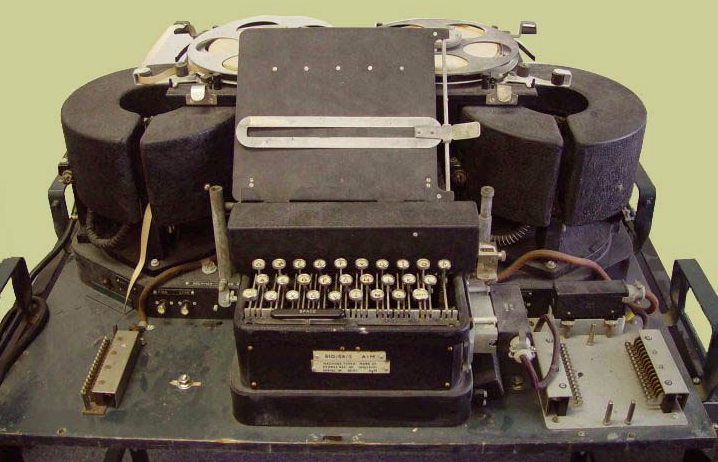
Typex is an electromechanical rotary cryptographic machine developed in Great Britain in 1934 under the direction of Wing Commander OGW Lywood and three other members of the Royal Air Force (RAF). As already mentioned, this was the British version of the Enigma machine. The prototype of the crypto machine was ready by 1935, in early 1937, the first batch of Typex Mark I machines in the amount of 30 pieces was available to the Royal Air Force. Later the device was improved and the light was seen by the more versatile Typex Mark II, it was used during World War II not only to the air force, but also to ground forces and the navy. Typex is sometimes referred to as “Type X” or “TypeX”. Later machine variants are known as BID / 08/2 and BID / 08/3.
You can get acquainted, so to speak, with interesting specimens of Typex cars in the museum of the legendary Bletchley Park (UK). Although there are several different types of Typex cars, we’ll look at the Mark 23 in more detail.
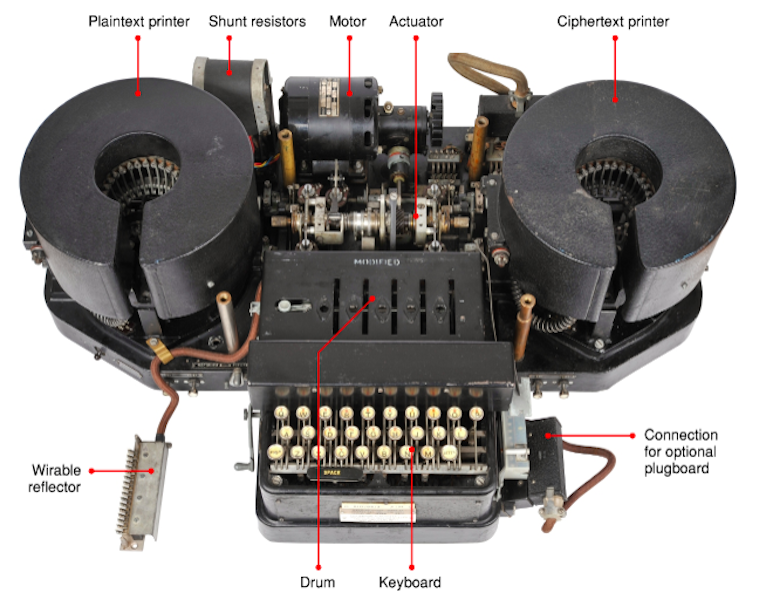
On the front panel there was a keyboard, nothing ordinary: three rows with keys plus a space. Immediately behind the keyboard was a rotor drum (basket), which housed five rotor wheels. The keyboard and the rotor basket are two elements of the machine, which are a copy of the German Enigma. There was an input disk and a reflector on which five rotors were placed (two of them are static). The difference from the Enigma is 5 rotors, and not from 3 to 5, the improved design of the rotors themselves. Behind the basket with the rotors there was a driving mechanism or an executive mechanism. The engine started the car and synchronized the work of all its components. The two large black cylinders on the left and right are printers for plaintext and ciphertext, respectively. The text was printed on paper tape.
The 32-pin connector to the left of the keyboard was designed to connect a plug-in switch, which made it possible to replace the reflector. This feature was made possible in the late version of the Mark 22, it was not in the original Mark II car. The 33-pin Jones connector to the right of the keyboard allowed you to connect a one-way plug-in switch between the keyboard and the input disk, just like an Enigma.
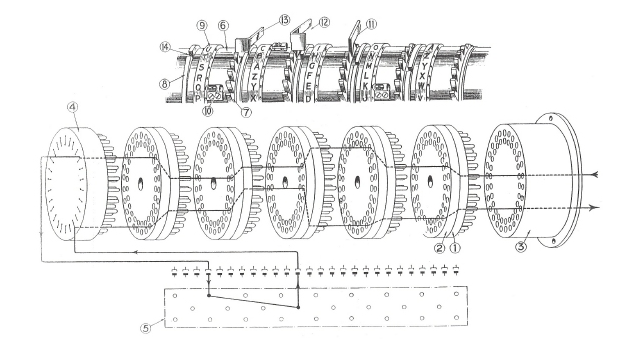
The figure shows a simplified diagram that shows how the Typex machine scrambler worked. On the right was the input disk and reflector, each with 26 contacts. 5 rotor disks were placed between the reflector and the input disk, the two right rotors were static (they did not rotate during encryption), the other three were set in motion by a stepped mechanism, which is similar (but not identical) to the Enigma stepping mechanism.

Enigma Simplified Circuit

Typex Simplified Circuit
Typex rotors are very similar to the rotors of the German Enigma machine. The entire circumference of the rotor - 26 letters and 26 contacts on both sides. Each rotor had a disk wheel, which was used to change the starting position and was driven by a gear disk on the right. To increase reliability, each contact has been doubled. 2 - static rotors, although it was possible to set them in motion manually, and three moving ones. In order to cause more frequent turns of the wheels (irregular stepping), there were several notches on the wheels (for example, 5, 7 and 9). The rotors are usually stored in a wooden box.
The following Typex models are currently known:
Typex Mark III can be considered as a portable version of Typex Mark II. It used the same encryption rotors as in the Mark II, and the appearance of the machines is identical (especially the front part).
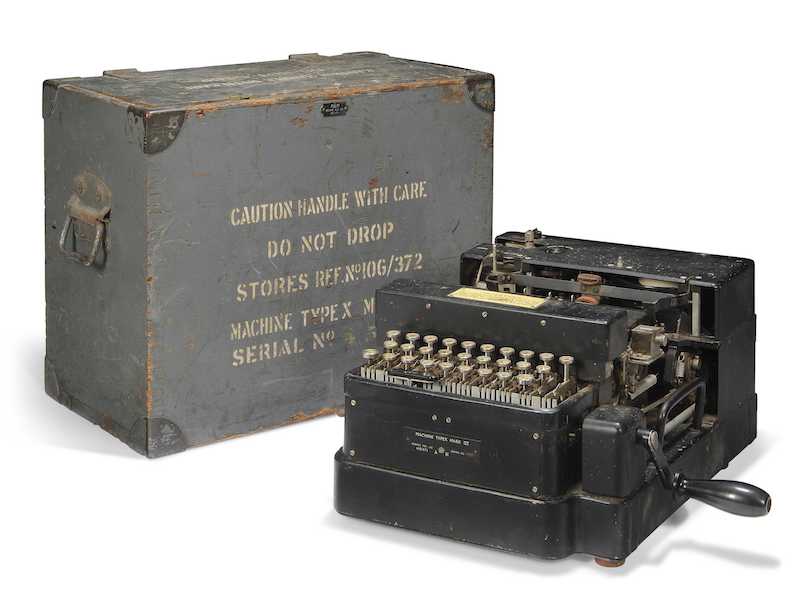

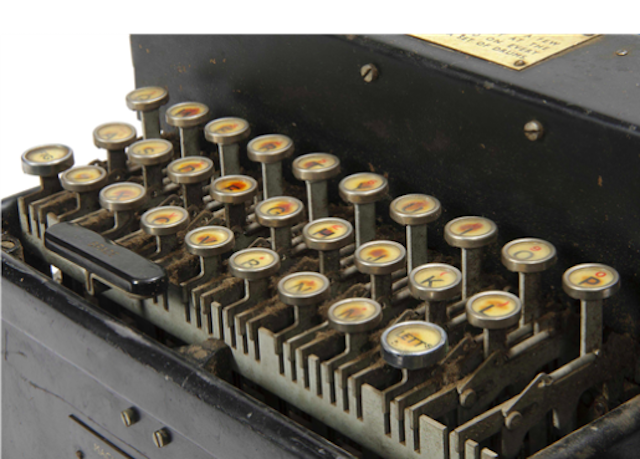
The machine was equipped with a manual control, but it was possible to connect the drive with an electric motor. 60 characters were processed in a minute, the operator typed the text with his left hand, while at the same time he was turning the handle with his right hand. Behind the machine was a small printer with a rotating print head, which displays text on a 9.6 mm paper tape.

Typex Mark VI "reduced" version of the Typex crypto machine, controlled by an electric motor, the text was displayed directly on a paper tape of 9.6 mm. The machine itself is smaller than the Mark III, but the frontal part is longer, the printer was attached to the right side of the encryption unit.
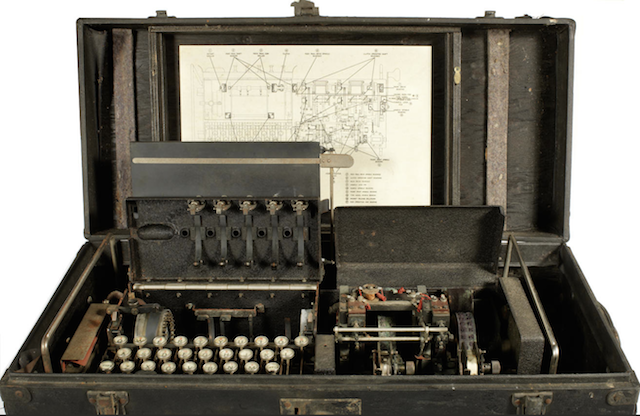
The rotor wheels differed from the rotors of other Typex models, their diameter was smaller. A large 32-pin Strowger connector to the left of the keyboard was used to connect an external power supply.
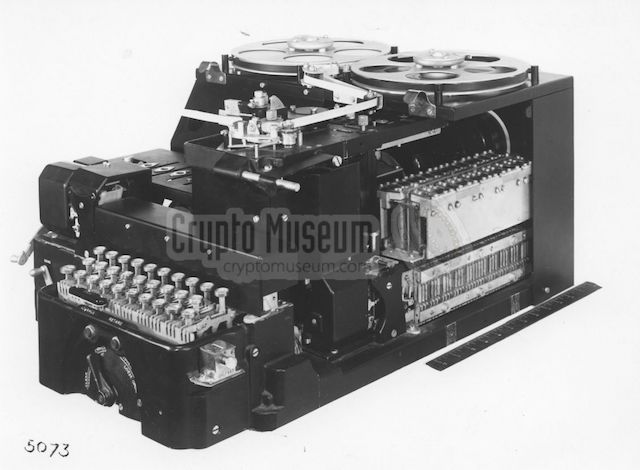
Little is known about Typex Mark VIII, sometimes a description of a Typex Mark II cryptographic machine with a device for punching holes in a paper tape corresponding to the signs of Morse’s telegraphic alphabet. Although Typex Mark VIII is from the Typex Mark II family, it had a slightly different mechanical “layout”.
The basket (drum) with the rotors was moved to the left, this in turn made room for the puncher, located just behind the keyboard.
Typex Mark 22 - the most famous cryptomachine Typex family. Used by the UK for messaging at the highest level during World War II. At the heart of the Typex Mark II plus additional plug-in switches installed on both sides of the keyboard.
Some Mark 22 machines have been modified (Mark 23) for compatibility with the SIGABA American crypto machine.
The Typex Mark 23 base was the Typex Mark 22, it was slightly modified for use as a Combined Cipher Machine (CCM). Four profiles were added to the CCM (in the form of brown rods in the photo) for the rotor basket, an additional connector to the right of the keyboard.
The Mark 23 was used during World War II to communicate with the Americans, who on their side used the modified SIGABA crypto machine.
On the part of the Americans and the British, an attempt was made to create a version of the matching device that would allow the exchange of information using Typex on one side, and on the other side to use SIGABA. Combined Cipher Machine (CCM) - this is how this miracle of technology was baptized. Interestingly, the Americans were familiar with the British machine gun, which would have been modified in the CCM, in turn, the British did not even realize the existence of SIGABA and had no idea which cryptomachine would become the basis of the American version of the SCM.
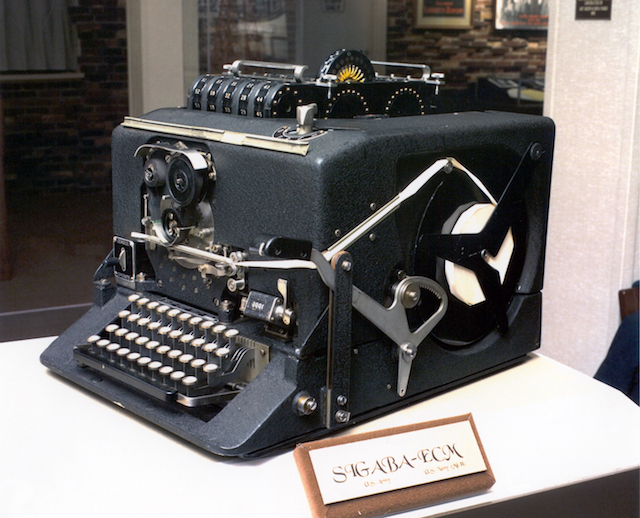
American SIGABA
So two variants of SMS were created, despite the fact that the machines were compatible in operation, in fact, they were very different. Conversion kits for both machines were developed and supplied by the NSA. After the conversion, the machines were equipped with five SIGABA rotors. Modified machines began to be used from November 1943 and as we know, they have never been compromised.
Portex was a British electromechanical cryptomachine that was used by the UK secret services in the 1940s and 1950s. The car is similar to the German Enigma, although it had 8 rotors with 26 contacts each with irregular stepping.

The text was entered one character at a time, the disk with the alphabet was set on the left to the desired letter, while it was necessary to scroll the handle to the right. Then the letter causes an electric current to the drum, starting with the leftmost wheel. The current that leaves the wheels on the right is used to drive the printer, which is installed on the left. The exit enters the strip (pre-wetted), which leaves the car on the left.
In addition to the similarity with the German Enigma, Portex borrowed some of the features of the Swedish-Swiss Hagelin machines. The design of the printer, the alphabet disk and the character counter (all of which were installed to the left of the encryption rotors) are similar to the portable M-209 and C-446. Portex can be called a hybrid between Hagelin M-209 and Enigma G.
Cryptomachine was used not only by the British services, but also by the Canadian army. The civilian version of the crypto machine was manufactured in black, the military version in green, and was also equipped with additional command buttons. Ahead were eight electric encoders, which mechanically moved with each key press. On the left was a printer, a text disk (ring with alphabet) and a counter. Behind the rotors were several solenoids to control the stepping mechanism of the crypto machine. At the moment, how exactly the mechanism worked, alas, is unknown.
The British Electromechanical Cryptomachine, was developed and released in the UK in late 1949 or early 1950. She came to replace the British version of the Combined Cipher Machine (CCM). The British Singlet had 10 rotors (instead of 8) with 36 contacts, similar to those of the American KL-7 compatible rotors. The rotors are reported to be compatible with the KL-7 rotors, and can be used in both machines (out of 10 the rotor is eight, the other two will be soothers). The device is known under the code name BID / 60.

On the front panel was a regular keyboard with 29 keys and a space. Behind it was a removable drum (cylinder) with 10 electric encoders. Right ahead - roll with paper tape (5-bit). According to the surviving documents, the cryptomachine was used by the British army to communicate with Australia, New Zealand.
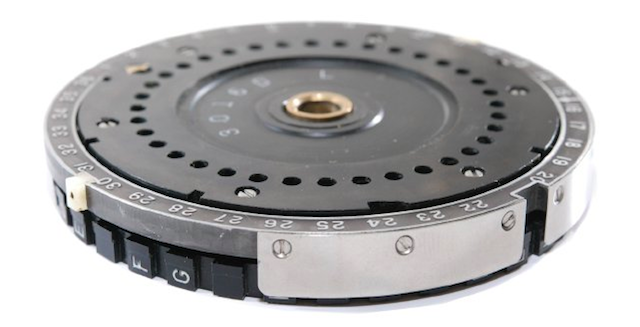
Singlet rotors are identical to those used in the American KL-7 (1952). KL-7 was developed by the US National Security Agency (NSA), it is likely that the rotors were a joint product of the US and the UK. In any case, they were produced in the UK by Egen Electric on the island of Canva.

Noreen is a portable autonomous OTT cryptographic machine developed in Great Britain in the early 1960s, it was used for diplomatic negotiations by the British Commonwealth as a replacement (or addition) to a compatible Rockex crypto machine. Noreen is known as BID / 590 or Mk-854M.
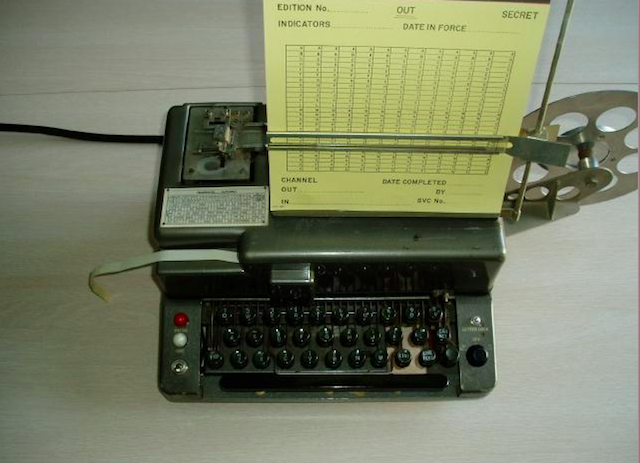
Without an external device for feeding the tape, the dimensions of the machine were only 33 x 27.5 x 17 cm, which made it one of the “smallest” among the cryptomachines that used the Vernam cipher. It was compatible with Rockex, using the same 6-level ribbons for keys, but, unlike Rockex, Noreen could not output directly to punched tape. Encrypted (or decrypted) text was printed on paper tape (9 mm) using a rotary printer located on the front panel of the device. Then paper tapes were pasted on blank sheets of paper and reprinted on a teleprinter.
Noreen was produced in the UK in the 1960s, used by the Foreign and Commonwealth Office (FCO). According to the agreement, the crypto machine technology was sent to Canada, here it was used in the Office of External Relations. The car was delivered to Australia and New Zealand, but only for confidential communication with the UK.
Initially, Noreen was secret cryptographic equipment, it served until the beginning of 1980, later its device was declassified.
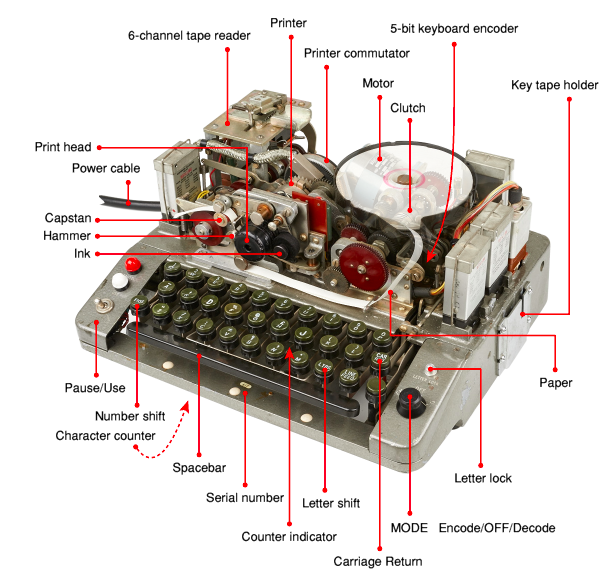
Noreen consisted of three sections: the keyboard in front, the mechanical part in the back and electronic circuits. The machine was powered by a battery pack or power supply,
the mode switch MODE was in the upper right corner: EN for encoding, DE for decoding. The machine could be used as a typewriter by setting the switch to OFF.

An external paper feed is usually attached to the right. Noreen had only two physical connections that were located behind the car. A fixed black stranded cable with a 10-pin connector on the end was used to connect the device to a special TEMPEST battery pack. There was also a 3-pin Bulgin connector for connecting a switch on a tape drive mechanism, which was used to determine whether the tape feeder is available for encoding or decoding.


The image above compares two tape formats with a key sequence. On the right - the usual 5-level, on the left - the tape Rockex / Noreen (red), it is characterized by "unusual" width, added an additional sixth level. Separate tapes were used for encoding and decoding. They differed in color. In the UK, the tape for encoding was usually green, the decoding tape was red. In Canada, the ribbons were colored yellow and red, respectively. The keyboard consisted of 32 keys (31 one key with letters and a space).

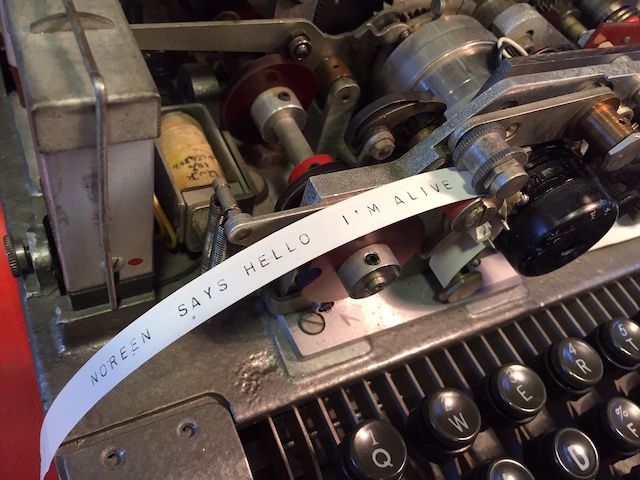
Noreen brought the text directly to a paper tape, located slightly above the keyboard (moved from right to left). The tape was a narrow strip of paper with a width of about 9.4 mm, similar type tapentas were used in the American M-209 and Soviet Violet. A strip of paper was inserted horizontally into the black paper holder (right) and passed through the print head (left). The print head had two rows: one with letters (in front), the second with numbers and punctuation.
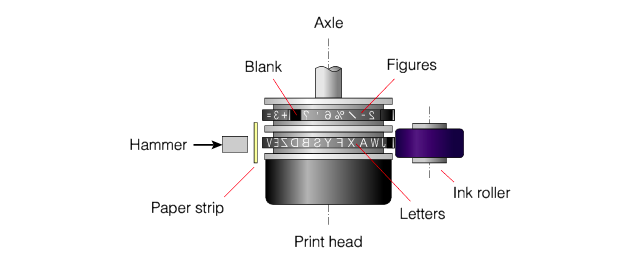
Noreen had a non-standard 6-level device for reading from the Creed tape, it was on the left side.
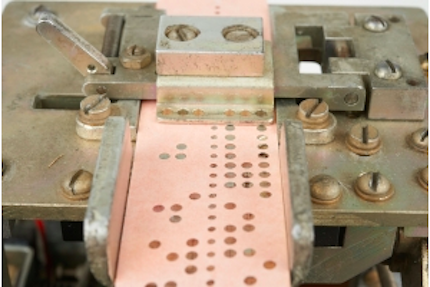
Tape reader
The achievements of Great Britain, its intelligence services and scientists in the art of cryptography are unquestionably great, which only costs Bletchley Park, which became the residence of the HSE (Public School of Codes and Ciphers), the great hacker Alan Turing, a cryptological Bombe - the British response to the German Enigma. The list can be continued for a long time, it will be fascinating and full of information. Read about the legendary Bletchley Park, the greatest achievement of Great Britain in 1939-1945, and possibly the whole XX century as a whole can be found in one of the articles .
Thank you for staying with us. Do you like our articles? Want to see more interesting materials? Support us by placing an order or recommending to friends, 30% discount for Habr users on a unique analogue of the entry-level servers that we invented for you: The whole truth about VPS (KVM) E5-2650 v4 (6 Cores) 10GB DDR4 240GB SSD 1Gbps from $ 20 or how to share the server? (Options are available with RAID1 and RAID10, up to 24 cores and up to 40GB DDR4).
Dell R730xd 2 times cheaper? Only we have 2 x Intel Dodeca-Core Xeon E5-2650v4 128GB DDR4 6x480GB SSD 1Gbps 100 TV from $ 249 in the Netherlands and the USA! Read about How to build an infrastructure building. class c using servers Dell R730xd E5-2650 v4 worth 9000 euros for a penny?

The UK boasts a wide range of production of various devices, ranging from mechanical rotary machines and ending completely electronic. For many years, they have been developed by the Government Communications Service (GCHQ), sometimes in collaboration with the US National Security Agency (NSA). By the first half of the last century, the importance of creating and using their cryptomachines was clear as day: in 1926 a special commission was created, the purpose of which was to research and analyze already existing secret encryption systems (still mechanical).
Why is 1926? Yes, everything is simple, this is the year for the first time Germany used cryptographic machines in military affairs. This was a kind of impetus for other countries to develop and develop their own methods of encryption and decryption. The championship in the theoretical development of machines belongs to the Poles and the French, the British continued the cryptological analysis after the occupation of Poland and France.
')
Typex
An existing commercial version of the German Enigma was taken as a prototype.

Typex is an electromechanical rotary cryptographic machine developed in Great Britain in 1934 under the direction of Wing Commander OGW Lywood and three other members of the Royal Air Force (RAF). As already mentioned, this was the British version of the Enigma machine. The prototype of the crypto machine was ready by 1935, in early 1937, the first batch of Typex Mark I machines in the amount of 30 pieces was available to the Royal Air Force. Later the device was improved and the light was seen by the more versatile Typex Mark II, it was used during World War II not only to the air force, but also to ground forces and the navy. Typex is sometimes referred to as “Type X” or “TypeX”. Later machine variants are known as BID / 08/2 and BID / 08/3.
You can get acquainted, so to speak, with interesting specimens of Typex cars in the museum of the legendary Bletchley Park (UK). Although there are several different types of Typex cars, we’ll look at the Mark 23 in more detail.
Typex Features

On the front panel there was a keyboard, nothing ordinary: three rows with keys plus a space. Immediately behind the keyboard was a rotor drum (basket), which housed five rotor wheels. The keyboard and the rotor basket are two elements of the machine, which are a copy of the German Enigma. There was an input disk and a reflector on which five rotors were placed (two of them are static). The difference from the Enigma is 5 rotors, and not from 3 to 5, the improved design of the rotors themselves. Behind the basket with the rotors there was a driving mechanism or an executive mechanism. The engine started the car and synchronized the work of all its components. The two large black cylinders on the left and right are printers for plaintext and ciphertext, respectively. The text was printed on paper tape.
The 32-pin connector to the left of the keyboard was designed to connect a plug-in switch, which made it possible to replace the reflector. This feature was made possible in the late version of the Mark 22, it was not in the original Mark II car. The 33-pin Jones connector to the right of the keyboard allowed you to connect a one-way plug-in switch between the keyboard and the input disk, just like an Enigma.

The figure shows a simplified diagram that shows how the Typex machine scrambler worked. On the right was the input disk and reflector, each with 26 contacts. 5 rotor disks were placed between the reflector and the input disk, the two right rotors were static (they did not rotate during encryption), the other three were set in motion by a stepped mechanism, which is similar (but not identical) to the Enigma stepping mechanism.

Enigma Simplified Circuit

Typex Simplified Circuit
Rotary wheels
Typex rotors are very similar to the rotors of the German Enigma machine. The entire circumference of the rotor - 26 letters and 26 contacts on both sides. Each rotor had a disk wheel, which was used to change the starting position and was driven by a gear disk on the right. To increase reliability, each contact has been doubled. 2 - static rotors, although it was possible to set them in motion manually, and three moving ones. In order to cause more frequent turns of the wheels (irregular stepping), there were several notches on the wheels (for example, 5, 7 and 9). The rotors are usually stored in a wooden box.
The following Typex models are currently known:
- Typex mark i
- Typex mark ii
- Typex mark iii
- Typex mark vi
- Typex Mark VIII
- Typex Mark 22 - BID / 08/2
- Typex Mark 23 - BID / 08/3
- CCM Mark III
- Typex Mark X - Mercury
Typex mark iii
Typex Mark III can be considered as a portable version of Typex Mark II. It used the same encryption rotors as in the Mark II, and the appearance of the machines is identical (especially the front part).



The machine was equipped with a manual control, but it was possible to connect the drive with an electric motor. 60 characters were processed in a minute, the operator typed the text with his left hand, while at the same time he was turning the handle with his right hand. Behind the machine was a small printer with a rotating print head, which displays text on a 9.6 mm paper tape.
Typex mark vi

Typex Mark VI "reduced" version of the Typex crypto machine, controlled by an electric motor, the text was displayed directly on a paper tape of 9.6 mm. The machine itself is smaller than the Mark III, but the frontal part is longer, the printer was attached to the right side of the encryption unit.

The rotor wheels differed from the rotors of other Typex models, their diameter was smaller. A large 32-pin Strowger connector to the left of the keyboard was used to connect an external power supply.
Typex Mark VIII

Little is known about Typex Mark VIII, sometimes a description of a Typex Mark II cryptographic machine with a device for punching holes in a paper tape corresponding to the signs of Morse’s telegraphic alphabet. Although Typex Mark VIII is from the Typex Mark II family, it had a slightly different mechanical “layout”.
The basket (drum) with the rotors was moved to the left, this in turn made room for the puncher, located just behind the keyboard.
Typex mark 22
Typex Mark 22 - the most famous cryptomachine Typex family. Used by the UK for messaging at the highest level during World War II. At the heart of the Typex Mark II plus additional plug-in switches installed on both sides of the keyboard.
He took not a simple, but an electric typewriter, in which the keys and letter levers are wired to the relay. Breaking the conductors and inserting an intermediate link between them - the switch, Creech got the opportunity to interchange the wires in any order by simply swapping the plugs on the outer panel of the device. The main secret of the device was not its device, but the key — the location of the plugs, known only to the sender and addressee.The plug-in switch on the right was inserted between the keyboard and the input disk, in the same place as the plug-in switch on the Enigma. However, since it used single wires (as compared to wired pairs on the Enigma), this allowed for a greater number of permutations and, therefore, provided better encryption protection. This made the Typex Mark 22 an analogue of the famous “Riddle”. After breaking the Enigma keys, the premises in Bletchley Park were equipped “to the limit” with Typex Mark 22 cryptomachines, which were used to decipher a huge number of German messages.
Some Mark 22 machines have been modified (Mark 23) for compatibility with the SIGABA American crypto machine.
Typex mark 23
The Typex Mark 23 base was the Typex Mark 22, it was slightly modified for use as a Combined Cipher Machine (CCM). Four profiles were added to the CCM (in the form of brown rods in the photo) for the rotor basket, an additional connector to the right of the keyboard.
The Mark 23 was used during World War II to communicate with the Americans, who on their side used the modified SIGABA crypto machine.
On the part of the Americans and the British, an attempt was made to create a version of the matching device that would allow the exchange of information using Typex on one side, and on the other side to use SIGABA. Combined Cipher Machine (CCM) - this is how this miracle of technology was baptized. Interestingly, the Americans were familiar with the British machine gun, which would have been modified in the CCM, in turn, the British did not even realize the existence of SIGABA and had no idea which cryptomachine would become the basis of the American version of the SCM.

American SIGABA
So two variants of SMS were created, despite the fact that the machines were compatible in operation, in fact, they were very different. Conversion kits for both machines were developed and supplied by the NSA. After the conversion, the machines were equipped with five SIGABA rotors. Modified machines began to be used from November 1943 and as we know, they have never been compromised.
Portex BID / 50/1
Portex was a British electromechanical cryptomachine that was used by the UK secret services in the 1940s and 1950s. The car is similar to the German Enigma, although it had 8 rotors with 26 contacts each with irregular stepping.

The text was entered one character at a time, the disk with the alphabet was set on the left to the desired letter, while it was necessary to scroll the handle to the right. Then the letter causes an electric current to the drum, starting with the leftmost wheel. The current that leaves the wheels on the right is used to drive the printer, which is installed on the left. The exit enters the strip (pre-wetted), which leaves the car on the left.
In addition to the similarity with the German Enigma, Portex borrowed some of the features of the Swedish-Swiss Hagelin machines. The design of the printer, the alphabet disk and the character counter (all of which were installed to the left of the encryption rotors) are similar to the portable M-209 and C-446. Portex can be called a hybrid between Hagelin M-209 and Enigma G.
Cryptomachine was used not only by the British services, but also by the Canadian army. The civilian version of the crypto machine was manufactured in black, the military version in green, and was also equipped with additional command buttons. Ahead were eight electric encoders, which mechanically moved with each key press. On the left was a printer, a text disk (ring with alphabet) and a counter. Behind the rotors were several solenoids to control the stepping mechanism of the crypto machine. At the moment, how exactly the mechanism worked, alas, is unknown.
Singlet BID / 60
The British Electromechanical Cryptomachine, was developed and released in the UK in late 1949 or early 1950. She came to replace the British version of the Combined Cipher Machine (CCM). The British Singlet had 10 rotors (instead of 8) with 36 contacts, similar to those of the American KL-7 compatible rotors. The rotors are reported to be compatible with the KL-7 rotors, and can be used in both machines (out of 10 the rotor is eight, the other two will be soothers). The device is known under the code name BID / 60.

On the front panel was a regular keyboard with 29 keys and a space. Behind it was a removable drum (cylinder) with 10 electric encoders. Right ahead - roll with paper tape (5-bit). According to the surviving documents, the cryptomachine was used by the British army to communicate with Australia, New Zealand.

Singlet rotors are identical to those used in the American KL-7 (1952). KL-7 was developed by the US National Security Agency (NSA), it is likely that the rotors were a joint product of the US and the UK. In any case, they were produced in the UK by Egen Electric on the island of Canva.
Noreen BID / 590

Noreen is a portable autonomous OTT cryptographic machine developed in Great Britain in the early 1960s, it was used for diplomatic negotiations by the British Commonwealth as a replacement (or addition) to a compatible Rockex crypto machine. Noreen is known as BID / 590 or Mk-854M.

Without an external device for feeding the tape, the dimensions of the machine were only 33 x 27.5 x 17 cm, which made it one of the “smallest” among the cryptomachines that used the Vernam cipher. It was compatible with Rockex, using the same 6-level ribbons for keys, but, unlike Rockex, Noreen could not output directly to punched tape. Encrypted (or decrypted) text was printed on paper tape (9 mm) using a rotary printer located on the front panel of the device. Then paper tapes were pasted on blank sheets of paper and reprinted on a teleprinter.
Noreen was produced in the UK in the 1960s, used by the Foreign and Commonwealth Office (FCO). According to the agreement, the crypto machine technology was sent to Canada, here it was used in the Office of External Relations. The car was delivered to Australia and New Zealand, but only for confidential communication with the UK.
Initially, Noreen was secret cryptographic equipment, it served until the beginning of 1980, later its device was declassified.

Noreen consisted of three sections: the keyboard in front, the mechanical part in the back and electronic circuits. The machine was powered by a battery pack or power supply,
the mode switch MODE was in the upper right corner: EN for encoding, DE for decoding. The machine could be used as a typewriter by setting the switch to OFF.

An external paper feed is usually attached to the right. Noreen had only two physical connections that were located behind the car. A fixed black stranded cable with a 10-pin connector on the end was used to connect the device to a special TEMPEST battery pack. There was also a 3-pin Bulgin connector for connecting a switch on a tape drive mechanism, which was used to determine whether the tape feeder is available for encoding or decoding.


The image above compares two tape formats with a key sequence. On the right - the usual 5-level, on the left - the tape Rockex / Noreen (red), it is characterized by "unusual" width, added an additional sixth level. Separate tapes were used for encoding and decoding. They differed in color. In the UK, the tape for encoding was usually green, the decoding tape was red. In Canada, the ribbons were colored yellow and red, respectively. The keyboard consisted of 32 keys (31 one key with letters and a space).

Printing device

Noreen brought the text directly to a paper tape, located slightly above the keyboard (moved from right to left). The tape was a narrow strip of paper with a width of about 9.4 mm, similar type tapentas were used in the American M-209 and Soviet Violet. A strip of paper was inserted horizontally into the black paper holder (right) and passed through the print head (left). The print head had two rows: one with letters (in front), the second with numbers and punctuation.

Noreen had a non-standard 6-level device for reading from the Creed tape, it was on the left side.

Tape reader
The achievements of Great Britain, its intelligence services and scientists in the art of cryptography are unquestionably great, which only costs Bletchley Park, which became the residence of the HSE (Public School of Codes and Ciphers), the great hacker Alan Turing, a cryptological Bombe - the British response to the German Enigma. The list can be continued for a long time, it will be fascinating and full of information. Read about the legendary Bletchley Park, the greatest achievement of Great Britain in 1939-1945, and possibly the whole XX century as a whole can be found in one of the articles .
Thank you for staying with us. Do you like our articles? Want to see more interesting materials? Support us by placing an order or recommending to friends, 30% discount for Habr users on a unique analogue of the entry-level servers that we invented for you: The whole truth about VPS (KVM) E5-2650 v4 (6 Cores) 10GB DDR4 240GB SSD 1Gbps from $ 20 or how to share the server? (Options are available with RAID1 and RAID10, up to 24 cores and up to 40GB DDR4).
Dell R730xd 2 times cheaper? Only we have 2 x Intel Dodeca-Core Xeon E5-2650v4 128GB DDR4 6x480GB SSD 1Gbps 100 TV from $ 249 in the Netherlands and the USA! Read about How to build an infrastructure building. class c using servers Dell R730xd E5-2650 v4 worth 9000 euros for a penny?
Source: https://habr.com/ru/post/358456/
All Articles